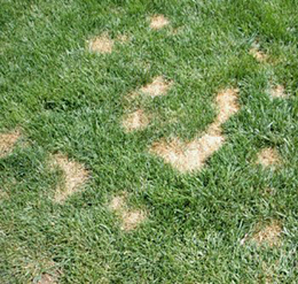 A lawn can go from lush to lousy with just a few, or even a single, bare patch. Bare spots in your lawn can be the result of draught, chemical burn (including pet urine), disease, soil compaction (usually caused by heavy foot traffic), and weed or insect infestation. If the cause is heavy foot traffic, try to find a solution to minimize this traffic in the area. Perhaps you can install stepping stones or a gravel pathway to reroute traffic and protect your grass. If the turf has been damaged by pet urine, it will resemble a patch of straw in the center with a dark green ring around the outside. The urine acts much like a fertilizer burn. Ohio State University scientists recommend watering the area to dilute the concentration of urine. If you are able to keep the pet off the lawn, the grass can be reseeded. If insects or disease are the cause, investigate to determine the specific critters or disease to treat. Most treatment products require significant time after application to work before you can grow new grass. Information on the treatment product packaging will tell you how long to wait before sowing new grass seed. The good news is that bare spots can be repaired pretty easily. Here’s how: 1. Using a garden fork, dig up the area roughly 4 - 6" deep, breaking up any clumps. (If the problem was caused by a spilled chemical such as gasoline or an herbicide, remove several inches of surface soil.) 2. Mix in topsoil to enhance the soil quality and help the new grass seed receive better nutrients for a healthy start. 3. Cast a thin layer of seeds on the area, and then gently rake the seeds into the topsoil. Cover it with straw or burlap to hold in moisture and protect the seeds from birds. 4. Using a fine spray from a hose, keep the soil moist, but not drenched. Water the seeds in the early morning and evening every day to prevent the soil from drying out. This allows the roots from the grass seed to enter the soil. Once they start to sprout, water the lawn every day. 5. Once the grass is established and growing well, fertilize it with a general lawn fertilizer and begin mowing the patch with the rest of the lawn. If your lawn seems thin all over, try overseeding. You can follow the same, basic instructions for patching. Rake the area well, picking up any leaves or other debris on your grass. Cast the seeds over the turf, and then spread about a half an inch of compost or topsoil on the lawn. To get good seed-to-soil contact, gently rake the seeds and soil into the grass. Water daily.
4 Comments
4/6/2018 11:13:06 am
My yard could really use some help this spring to look better. I like how you pointed out that mixing topsoil with grass seed can give them a better start. I'd like to get rid of my bare patches as soon as possible, so how early do you recommend I try this?
Reply
Rodrigo dos Anjos
4/9/2018 05:02:02 am
Hi Earnest, thank you for your question, anytime now it can be done, you will have a better result if you do the reseeding from April 15th to March 15th, after that you will have problems with crabgrass, make sure that you don't bury the the grass seed, soil contact is important but grass seed doesn't like to be underground. Also you have to use Start fertilizer and as soon the grass germinates you apply pre emergent for crab grass. Good luck, feel free to contact me if you have any questio.
Reply
4/26/2024 08:46:32 am
Additionally, I was impressed by the additional lawn care tips you provided to ensure that the newly planted grass thrives. It's evident that you not only know how to repair bare spots but also how to maintain a healthy and beautiful lawn.
Reply
Leave a Reply. |
Archives
February 2024
AuthorRodrigo Dos Anjos Categories
All
|
Gardenin' Angels, Landscape Management & Construction
A preferred landscaper, serving Southeastern Massachusetts
11 Renker Drive, Easton, MA 02375
774-284-1171
[email protected]
Privacy Policy • Terms of Use

 RSS Feed
RSS Feed